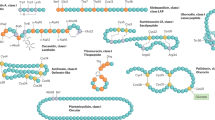Abstract
TETRACYCLINES are broad-spectrum bacteriostatic antibiotics which act by inhibiting protein synthesis1,2. However, their usefulness in combating bacterial infection has been sharply curtailed by the widespread occurrence in bacteria of tetracycline resistance encoded by genes located on extrachromosomal DNA elements called plasmids3,4. In many bacteria, notably Enterobacteriaceae, Pseudomonas and Staphylococcus, plasmid-mediated tetracycline resistance is inducible; the resistance level can be increased by preincubation of the cells in sub-inhibitory amounts of tetracycline5–8. Coincident with induced resistance is the induced synthesis of a plasmid-encoded inner membrane protein which we have designated TET protein8–10. Synthesis of this protein (and presumably most of the resistance determinant) is negatively regulated; a represser has been partially purified11. However, the mechanisms for plasmid-mediated tetracycline resistance are not yet clear, and there seems to be no degradation of the antibiotic in resistant cells10,12,13. Although resistant cells accumulate less tetracycline than do sensitive cells14,15, the moderately reduced uptake does not explain the much larger difference in sensitivity to the drug10,16,17. We report here that plasmid-containing resistant cells take up tetracycline by a different transport mechanism from that of sensitive cells. This altered transport seems to be responsible for at least part of the difference in tetracycline inhibition of sensitive as compared to resistant cells.
This is a preview of subscription content, access via your institution
Access options
Subscribe to this journal
Receive 51 print issues and online access
$199.00 per year
only $3.90 per issue
Buy this article
- Purchase on Springer Link
- Instant access to full article PDF
Prices may be subject to local taxes which are calculated during checkout
Similar content being viewed by others
References
Suzuki, I., Kaji, H. & Kaji, A. Proc. natn. Acad. Sci. U.S.A. 55, 1483–1490 (1966).
Högenauer, G. & Turnowsky, F. FEBS Lett. 26, 185–188 (1972).
Watanabe, T. Bact. Rev. 27, 87–115 (1963).
Falkow, S. Infectious Multiple Drug Resistance (Pion, London, 1975).
Izaki, K., Kiuchi, K. & Arima, K. J. Bact. 91, 628–633 (1966).
Unowsky, J. & Rachmeler, M. J. Bact. 92, 358–365 (1966).
Franklin, T. J. Biochem. J. 105, 371–378 (1967).
Levy, S. B. & McMurry, L. Biochem. biophys. Res. Commun. 56, 1060–1068 (1974).
Levy, S. B. in Drug-inactivating Enzymes and Antibiotic Resistance (eds Mitsuhashi, Rosival & Krčméry) 215–225 (Springer, Berlin, 1975).
Levy, S. B., McMurry, L., Onigman, P. & Saunders, R. M. in Topics in Infectious Diseases, Vol. 2 (eds Drews & Högenauer) 180–203 (Springer, Berlin, 1977).
Yang, H-L., Zubay, G. & Levy, S. B. Proc. natn. Acad. Sci. U.S.A. 73, 1509–1512 (1976).
DeZeeuw, J. R. J. Bact. 95, 498–506 (1968).
Sompolinsky, D., Krawitz, T., Zaidenzaig, Y. & Abramova, N. J. gen. Microbiol. 62, 341–349 (1970).
Arima, K. & Izaki, K. Nature 200, 192–193 (1963).
Franklin, T. J. & Godfrey, A. Biochem. J. 94, 54–60 (1965).
Reynard, A. M., Nellis, L. F. & Beck, M. E. Appl. Microbiol. 21, 71–75 (1971).
Levy, S. B. & McMurry, L. in Microbiology 1978 (ed. Schlessinger) 177–180 (Am. Soc. for Microbiol., Washington, 1978).
McMurry, L. & Levy, S. B. Antimicrob. Ag. Chem. 14, 201–209 (1978).
Foster, T. J., Howe, T. G. B. & Richmond, K. M. V. J. Bact. 124, 1153–1158 (1975).
Lehninger, A. L. Biochemistry, 429 (North, New York, 1975).
Berger, E. A. & Heppel, L. A. J. biol. Chem. 249, 7747–7755 (1974).
Wilson, D. B. J. Bact. 126, 1156–1165 (1976).
Levy, S. B. J. Bact. 108, 300–308 (Fig. 4) (1971).
Lennox, E. S. Virology 1, 190–206 (1955).
Curtiss, R. J. Bact. 89, 28–40 (1965).
Heppel, L. A. in Structure and Function of Biological Membranes (ed. Rothfield) 223–247 (Academic, New York, 1971).
Navashin, S. M., Beliavskaya, I. V., Sazykin, Y. O. & Gryaznova, N. S. in Drug-inactivating Enzymes and Antibiotic Resistance (eds Mitsuhashi, Rosival & Krčméry), 227–230 (Springer, Berlin, 1975).
Author information
Authors and Affiliations
Rights and permissions
About this article
Cite this article
LEVY, S., MCMURRY, L. Plasmid-determined tetracycline resistance involves new transport systems for tetracycline. Nature 276, 90–92 (1978). https://doi.org/10.1038/276090a0
Received:
Accepted:
Issue Date:
DOI: https://doi.org/10.1038/276090a0
This article is cited by
-
N eisseria gonorrhoeae non-susceptible to cephalosporins and quinolones in Northwest Ethiopia
BMC Infectious Diseases (2013)
-
Fluorometric determination of ethidium bromide efflux kinetics in Escherichia coli
Journal of Biological Engineering (2009)
-
Tetracycline uptake by susceptible Escherichia coli cells
Archives of Microbiology (1985)
-
Mechanism of action of carboxin and the development of resistance in yeast
Journal of Biosciences (1982)
Comments
By submitting a comment you agree to abide by our Terms and Community Guidelines. If you find something abusive or that does not comply with our terms or guidelines please flag it as inappropriate.



